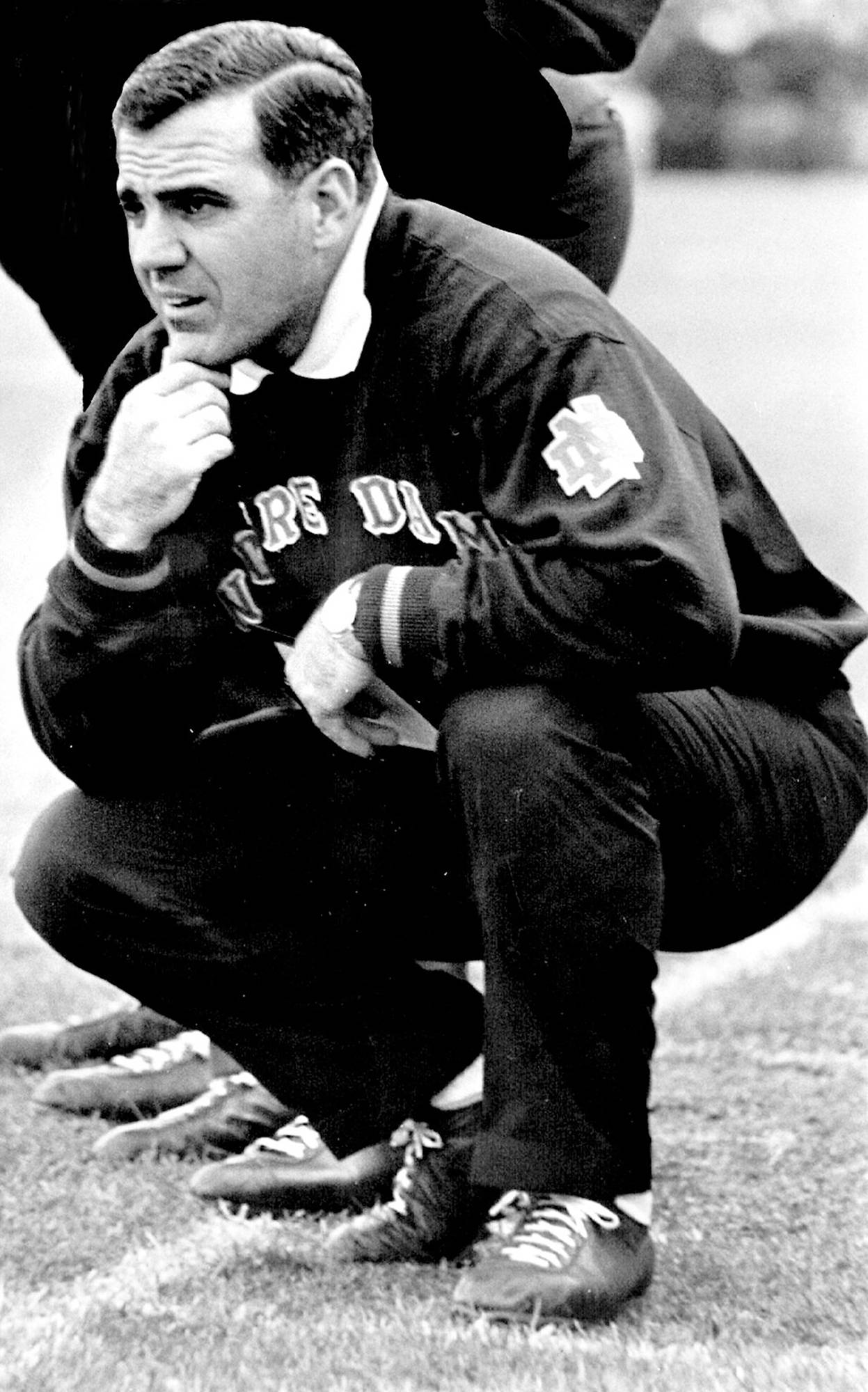Chicago Tribune
SOUTH BEND, Ind. — Ara Parseghian, a member of the College Football Hall of Fame who coached Notre Dame and Northwestern, has died. He was 94.
Parseghian, who was born May 21, 1923, in Akron, Ohio, recently spent time in a nursing care facility because of a hip infection. He returned to his Indiana home last week to receive 24-hour care.
Parseghian led the Irish to two national championships (1966, 1973) in 11 seasons in South Bend, Ind. Both of those teams were unbeaten. He had a 95-17-4 record at Notre Dame, where he also coached in what some called the “Game of the Century,” a 10-10 tie between his top-ranked Irish and No. 2 Michigan State in 1966.
“We didn’t go for a tie; the game ended in a tie,” Parseghian told the Chicago Tribune in 2016 when reminded he often was criticized for letting the clock wind down. “Christ, somebody ought to wake up to that.”
Before he arrived in South Bend, he spent eight seasons as Northwestern’s coach, posting a 36-35-1 record.
Parseghian’s players revered him for his ability to inspire them — and switch them to their most beneficial positions on the field.
He moved Paul Flatley to a flanker-end spot, and Flatley flourished as Northwestern’s top receiver before enjoying an eight-year career in the NFL.
“The Big Ten was 3 yards and a cloud of dust back then,” Flatley said, “but we didn’t have the depth that was needed to compete for the whole season. Ara said: ‘We’re going to open up the offense and let Tom Myers throw the football. Is there anybody who would like to try to catch it?’”
Jay Robertson, who played center on Northwestern’s 1962 team, called Parseghian “a beautiful football strategist … who didn’t resort to gimmicks.”
“On Monday we’d go over the scouting report and Ara had you sold,” Robertson said. “His facts were straight and he had a machine-gun delivery: ‘Boys, they can’t cover this! And if they do, this will be open.’ You’d leave the room and say, ‘I don’t care who we’re playing, we’re gonna kick their butt!’
“He was a great communicator without having to say a lot. His technical knowledge was really strong, but in the end his greatest desire was to be the team that hit the hardest.”
Parseghian’s college playing days were to begin at the University of Akron, but he left school and enlisted in the Navy, where he met Paul Brown, who co-founded and coached the Cleveland Browns.
After his stint in the Navy ended, he played halfback for Miami University in Ohio.
The Browns picked Parseghian in the 1947 All-America Football Conference draft, while the Steelers chose him in the 13th round of that year’s NFL draft.
Parseghian chose to play for the Browns, who won the AAFC championship in both of his seasons. His career ended in the second game of the 1949 season because of a hip injury.
Parseghian’s coaching career began at Miami in 1950, when Woody Hayes hired him to guide the freshman team. He took over as head coach the following year after Hayes left to coach Ohio State.
He led the Redskins to conference titles in 1954 and 1955, both undefeated seasons.
Parseghian became coach at Northwestern the following year, taking over for Lou Saban, a former teammate of Parseghian’s with the Browns.
He guided the Wildcats to the top of the AP poll in 1962 after victories against Ohio State and Notre Dame. Northwestern finished 7-2 that year.
Joe Ruklick, who starred on NU’s basketball team, said: “We all believed it was a gift to live in the Ara era. His example was so strong, regardless of sport. He taught us dumb, young guys the meaning of dedication and the love of sacrifice for the cause.”
Parseghian left Evanston for South Bend after the 1963 season and became the first Irish coach since Knute Rockne not to have graduated from Notre Dame.
When Parseghian retired in 1974, he was second behind Rockne in career victories at Notre Dame.
“A good coach will make his players see what they can be rather than what they are,” Parseghian once said.
He was elected to the College Football Hall of Fame in 1980. He also is a member of the Miami University Hall of Fame and the Indiana Football Hall of Fame.
Both Notre Dame and Miami have statues of Parseghian outside their stadiums. He was 170-58-6 in 24 seasons as a college head coach.
Parseghian began his broadcasting career as a color analyst for ABC Sports’ regional and national college football broadcasts in 1975, a job he held until he began working for CBS in 1982.
In 1994, Parseghian and his son and daughter-in-law founded the Ara Parseghian Medical Research Foundation with the purpose of helping to find a cure for Niemann-Pick Disease, a rare disorder that caused the death of three of Parseghian’s grandchildren.
“The pain of losing our three youngest grandchildren is almost unbearable,” he once said. “I think of other grandparents whose grandchild has recently been diagnosed with NPC. We will keep up the fight for them and all families afflicted with this terrible disease.”
Parseghian also was involved in trying to find a cure for multiple sclerosis, which claimed his daughter Karan’s life in 2013.
———
(c)2017 Chicago Tribune
Visit the Chicago Tribune at www.chicagotribune.com
Distributed by Tribune Content Agency, LLC.
—————
PHOTOS (for help with images, contact 312-222-4194): Parseghian


